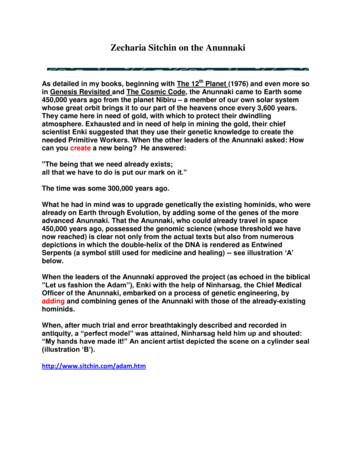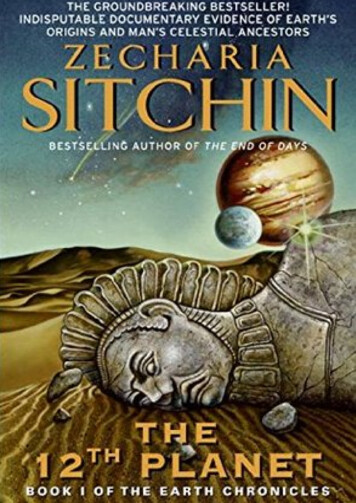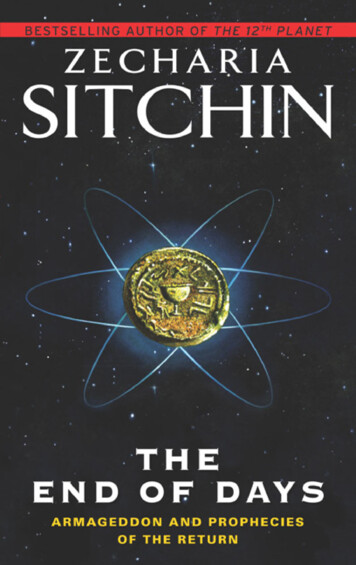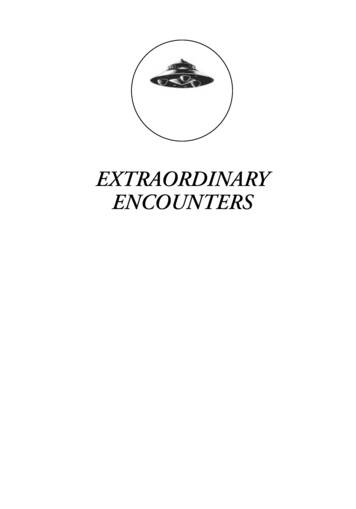
Transcription
Zecharia Sitchin on the AnunnakiAs detailed in my books, beginning with The 12th Planet (1976) and even more soin Genesis Revisited and The Cosmic Code, the Anunnaki came to Earth some450,000 years ago from the planet Nibiru – a member of our own solar systemwhose great orbit brings it to our part of the heavens once every 3,600 years.They came here in need of gold, with which to protect their dwindlingatmosphere. Exhausted and in need of help in mining the gold, their chiefscientist Enki suggested that they use their genetic knowledge to create theneeded Primitive Workers. When the other leaders of the Anunnaki asked: Howcan you create a new being? He answered:"The being that we need already exists;all that we have to do is put our mark on it.”The time was some 300,000 years ago.What he had in mind was to upgrade genetically the existing hominids, who werealready on Earth through Evolution, by adding some of the genes of the moreadvanced Anunnaki. That the Anunnaki, who could already travel in space450,000 years ago, possessed the genomic science (whose threshold we havenow reached) is clear not only from the actual texts but also from numerousdepictions in which the double-helix of the DNA is rendered as EntwinedSerpents (a symbol still used for medicine and healing) -- see illustration ‘A’below.When the leaders of the Anunnaki approved the project (as echoed in the biblical”Let us fashion the Adam”), Enki with the help of Ninharsag, the Chief MedicalOfficer of the Anunnaki, embarked on a process of genetic engineering, byadding and combining genes of the Anunnaki with those of the already-existinghominids.When, after much trial and error breathtakingly described and recorded inantiquity, a “perfect model” was attained, Ninharsag held him up and shouted:“My hands have made it!” An ancient artist depicted the scene on a cylinder seal(illustration ‘B’).http://www.sitchin.com/adam.htm
Zecharia Sitchin1Zecharia SitchinZecharia SitchinBornJuly 11, 1920Baku, Azerbaijan SSRDiedOctober 9, 2010 (aged 90)New York, New YorkCitizenship United StatesAlma mater London School of Economics, University of LondonKnown for Ancient astronautsWebsitehttp:/ / www. sitchin. com/Zecharia Sitchin (July 11, 1920 – October 9, 2010[1]) was an Azerbaijani-born American author of books proposingan explanation for human origins involving ancient astronauts. Sitchin attributes the creation of the ancient Sumerianculture to the Anunnaki, which he states was a race of extra-terrestrials from a planet beyond Neptune called Nibiru.He believed this hypothetical planet of Nibiru to be in an elongated, elliptical orbit in the Earth's own Solar System,asserting that Sumerian mythology reflects this view. Sitchin's books have sold millions of copies worldwide andhave been translated into more than 25 languages.Sitchin's ideas were rejected by scientists and academics, who dismiss his work as pseudoscience and pseudohistory.Sitchin's work has been criticized for flawed methodology and mistranslations of ancient texts as well as forincorrect astronomical and scientific claims.[2]
Zecharia SitchinEarly lifeSitchin was born in the then Azerbaijan SSR of the Soviet Union, but was raised in Palestine. He received a degreein economics from the University of London, and was an editor and journalist in Israel, before moving to New Yorkin 1952. While working as an executive for a shipping company, he taught himself Sumerian cuneiform and visitedseveral archaeological sites.[3][4]Ideas and worksSimilarly to earlier authors such as Immanuel Velikovsky and Erich von Däniken, Sitchin advocated hypotheses inwhich extraterrestrial events supposedly played a significant role in ancient human history.According to Sitchin's interpretation of Mesopotamian iconography and symbology, outlined in his 1976 book The12th Planet and its sequels, there is an undiscovered planet beyond Neptune that follows a long, elliptical orbit,reaching the inner solar system roughly every 3,600 years. This planet is called Nibiru (although Jupiter was theplanet associated with the god Marduk in Babylonian cosmology).[5] According to Sitchin, Nibiru (whose name wasreplaced with MARDUK in original legends by the Babylonian ruler of the same name in an attempt to co-opt thecreation for himself, leading to some confusion among readers) collided catastrophically with Tiamat (a goddess inthe Babylonian creation myth the Enûma Eliš), which he considers to be another planet once located between Marsand Jupiter. This collision supposedly formed the planet Earth, the asteroid belt, and the comets. Sitchin states thatwhen struck by one of planet Nibiru's moons, Tiamat split in two, and then on a second pass Nibiru itself struck thebroken fragments and one half of Tiamat became the asteroid belt. The second half, struck again by one of Nibiru'smoons, was pushed into a new orbit and became today's planet Earth.According to Sitchin, Nibiru (called "the twelfth planet" because, Sitchin claimed, the Sumerians' gods-givenconception of the Solar System counted all eight planets, plus Pluto, the Sun and the Moon) was the home of atechnologically advanced human-like extraterrestrial race called the Anunnaki in Sumerian myth, who Sitchin statesare called the Nephilim in Genesis. He wrote that they evolved after Nibiru entered the solar system and first arrivedon Earth probably 450,000 years ago, looking for minerals, especially gold, which they found and mined in Africa.Sitchin states that these "gods" were the rank-and-file workers of the colonial expedition to Earth from planet Nibiru.Sitchin wrote that Enki suggested that to relieve the Anunnaki, who had mutinied over their dissatisfaction with theirworking conditions, that primitive workers (Homo sapiens) be created by genetic engineering as slaves to replacethem in the gold mines by crossing extraterrestrial genes with those of Homo erectus.[6][7] According to Sitchin,ancient inscriptions report that the human civilization in Sumer, Mesopotamia, was set up under the guidance ofthese "gods", and human kingship was inaugurated to provide intermediaries between mankind and the Anunnaki(creating the "divine right of kings" doctrine). Sitchin believes that fallout from nuclear weapons, used during a warbetween factions of the extraterrestrials, is the "evil wind" described in the Lament for Ur that destroyed Ur around2000 BC. Sitchin states the exact year is 2024 BC.[8] Sitchin says that his research coincides with many biblicaltexts, and that biblical texts come originally from Sumerian writings.PopularitySince the release of his first book The 12th Planet in 1976, now in its 45th printing, Zecharia Sitchin has writtenseven other books as part of his Earth Chronicles series, as well as six other companion books, all of which are stillin print as of 2010. Sitchin's books have sold millions of copies worldwide and been published in more than 25languages, as well as in braille.[9] New York Times reporter Corey Kilgannon noted that despite academic dismissalof his work, Sitchin has "a devoted following of readers".[3]Critic Michael Heiser called Sitchin "arguably the most important proponent of the ancient astronaut hypothesis overthe last several decades".[10] Sitchin was a frequent guest on the Coast to Coast AM radio show, which in 2010presented Sitchin with a lifetime achievement award.[11] Gods of the New Millennium author Alan F. Alford admits2
Zecharia Sitchinhe initially became "infatuated" with Sitchin's hypotheses but later became a critic of Sitchin's interpretations ofmyth.[12]According to some writers, Sitchin's ideas along with those of Erich von Däniken may have influenced the beliefs ofthe religious sect of Raëlism,[13][14] and writer Mark Pilkington sees the mythology of Japan's Pana Wave religiousgroup as rooted in Sitchins The 12th Planet and its sequels.[15]The 1994 movie Stargate, directed by Roland Emmerich, and the 2009 video game The Conduit drew someconceptual inspiration from Sitchin's ideas,[16][17] while screenwriter Roberto Orci says the villains of the filmCowboys & Aliens were inspired by Sitchin's conceptualization of the Anunnaki as gold-mining aliens.[18]CriticismsCriticism of Sitchin's work falls primarily into three categories: translations and interpretations of ancient texts;astronomical and scientific observations; and literalism of myth.Translations and interpretationsWhen Sitchin wrote his books, only specialists could read the Sumerian language. However, sources such as the2006 book Sumerian Lexicon[19] have made the language more accessible to non-experts. Ancient language scholarMichael S. Heiser[20] states he has found many inaccuracies in Sitchin's translations and challenges interested partiesto use this book to check their validity.[15][21] Prof. Ronald H. Fritze,[22] author of the book Invented Knowledge:False History, Fake Science and Pseudo-religions,[22] mentions the example of Sitchin's claim that the Sumeriansign Din-Gir means "pure ones of the blazing rockets", adding that "Sitchin's assignment of meanings to ancientwords is tendentious and frequently strained."[23] Fritze also commented on Sitchin's methodology, writing that"When critics have checked Sitchin's references, they have found that he frequently quotes out of context ortruncates his quotes in a way that distorts evidence in order to prove his contentions. Evidence is presentedselectively and contradictory evidence is ignored."[23]Sitchin bases his arguments on his personal interpretations of pre-Nubian and Sumerian texts, and the seal VA 243.Sitchin wrote that these ancient civilizations knew of a twelfth planet, when in fact they only knew five.[24]Hundreds of Sumerian astronomical seals and calendars have been decoded and recorded, and the total count ofplanets on each seal has been five. Seal VA 243 has 12 dots that Sitchin identifies as planets. When translated, sealVA 243 reads "You're his Servant" which is now thought to be a message from a nobleman to a servant. Accordingto semitologist Michael S. Heiser, the so-called sun on Seal VA 243 is not the Sumerian symbol for the sun but is astar, and the dots are also stars.[24][25] The symbol on seal VA 243 has no resemblance to the hundreds ofdocumented Sumerian sun symbols.In a 1979 review of The Twelfth Planet, Roger W. Wescott,[26] Prof. of Anthropology and Linguistics at DrewUniversity, Madison, New Jersey, noted Sitchin's amateurishness with respect to the primacy of the Sumerianlanguage:Sitchin's linguistics seems at least as amateurish as his anthropology, biology, and astronomy. On p.370, for example, he maintains that "all the ancient languages . . . including early Chinese . . . stemmedfrom one primeval source -- Sumerian". Sumerian, of course, is the virtual archetype of what linguistictaxonomists call a language-isolate, meaning a language that does not fall into any of the well-knownlanguage-families or exhibit clear cognation with any known language. Even if Sitchin is referring towritten rather than to spoken language, it is unlikely that his contention can be persuasively defended,since Sumerian ideograms were preceded by the Azilian and Tartarian signaries of Europe as well as bya variety of script-like notational systems between the Nile and Indus rivers.[27]3
Zecharia SitchinAstronomical and scientific observationsSitchin's "planetary collision" view does superficially resemble a theory by modern astronomers—the giant impacttheory of the Moon's formation about 4.5 billion years ago by a body impacting with the newly-formed Earth.However, Sitchin's proposed series of rogue planetary collisions differ in both details and timing. As with ImmanuelVelikovsky's earlier Worlds in Collision thesis, Sitchin states that he has found evidence of ancient humanknowledge of rogue celestial motions in a variety of mythological accounts. In Velikovsky's case, theseinterplanetary collisions were supposed to have taken place within the span of human existence, whereas for Sitchinthese occurred during the early stages of planetary formation, but entered the mythological account passed down viathe alien race which purportedly evolved on Nibiru after these encounters.While Sitchin's scenario for the creation of the Solar System is hard to reconcile with the Earth's current small orbitaleccentricity of only 0.0167, Sitchin's supporters maintain that it would explain much of Earth's peculiar earlygeography due to cleaving from the celestial collision, i.e., solid continents on one side and a giant ocean on theother.According to former Immanuel Velikovsky assistant turned prolific critic,[28] C. Leroy Ellenberger,[28] "[Sitchinstates that] from an equal start, the Nefilim evolved on Nibiru 45 million years ahead of comparable development onEarth with its decidedly more favorable environment. Such an outcome is unlikely, to say the least, since Nibiruwould spend over 99% of its time beyond Pluto. Sitchin's explanation that heat from radioactive decay and a thickatmosphere keep Nibiru warm is absurd and does not address the problem of darkness in deep space. Alsounexplained is how the Nefilim, who evolved long after Nibiru arrived, knew what happened when Nibiru firstentered the solar system."[29]The scenario outlined by Sitchin, with Nibiru returning to the inner solar system regularly every 3,600 years,. . . implies an orbit with a semi-major axis of 235 astronomical units, extending from the asteroid belt totwelve times farther beyond the sun than Pluto. Elementary perturbation theory indicates that, under themost favorable circumstances of avoiding close encounters with other planets, no body with such aneccentric orbit would keep the same period for two consecutive passages. Within twelve orbits theobject would be either ejected or converted to a short period object. Thus, the failed search for atrans-Plutonian planet by T.C. Van Flandern, of the U.S. Naval Observatory, which Sitchin uses tobolster his thesis, is no support at all.[29]Sitchin in “the case of Adam’s alien genes”[30] states that 223 unique genes found by the Human Genome SequencingConsortium are without the required predecessors on the genomic evolutionary tree. Later researchers have arguedthat the conclusion from the Human Genome Sequencing Consortium cannot be drawn due to a lack of acomprehensive gene database for comparison. An analysis by Salzberg identified 40 potential genes laterallytransferred into the genome from prokaryotic organisms. Salzberg also argues that gene loss combined with samplesize effects and evolutionary rate variation provide an alternative, more biologically plausible explanation.[31]Literalism of mythPeter James, co-author of the controversial book Centuries of Darkness,[32] has criticized Sitchin both for ignoringthe world outside of Mesopotamia and more specifically for misunderstanding Babylonian literature:He uses the Epic of Creation Enuma Elish as the foundation for his cosmogony, identifying the young godMarduk, who overthrows the older regime of gods and creates the Earth, as the unknown "Twelfth Planet". Inorder to do as he interprets the Babylonian theogony as a factual account of the birth of the other "eleven"planets. The Babylonian names for the planets are established beyond a shadow of a doubt—Ishtar was thedeity of Venus, Nergal of Mars, and Marduk of Jupiter—and confirmed by hundreds ofastronomical/astrological tables and treatises on clay tablets and papyri from the Hellenistic period. Sitchinmerrily ignores all this and assigns unwarranted planetary identities to the gods mentioned in the theogony.4
Zecharia SitchinFor example, Apsu, attested as god of the primeval waters, becomes, of all things, the Sun! Ea, as it suitsSitchin, is sometimes planet Neptune and sometimes a spaceman. And the identity of Ishtar as the planetVenus, a central feature of Mesopotamian religion, is nowhere mentioned in the book—instead Sitchinarbitrarily assigns to Venus another deity from Enuma Elish, and reserves Ishtar for a role as a femaleastronaut.[33]William Irwin Thompson comments on what he calls Sitchin's 'literalism':What Sitchin sees is what he needs for his hypothesis. So figure 15 on page 40 is radiation therapy, andfigure 71 on page 136 is a god inside a rocket-shaped chamber. If these are gods, why are they stuckwith our cheap B movie technology of rockets, microphones, space-suits, and radiation therapy? If theyare gods, then why can't they have some really divine technology such as intradimensional worm-holetravel, antigravity, starlight propulsion, or black hole bounce rematerializations? Sitchin has constructedwhat appears to be a convincing argument, but when he gets close to single images on ancient tablets, hefalls back into the literalism of "Here is an image of the gods in rockets." Suddenly, ancient Sumer ismade to look like the movie set for Destination Moon. Erich Von Däniken's potboiler Chariots of theGods? has the same problem. The plain of Nazca in Peru is turned into a World War II landing strip.The gods can cross galactic distances, but by the time they get to Peru, their spaceships are imagined asWorld War II prop jobs that need an enormous landing strip. This literalization of the imaginationdoesn't make any sense, but every time it doesn't, you hear Sitchin say "There can be no doubt, but."[34]BibliographyEarth Chronicles volumes1. The 12th Planet, New York: Stein and Day, 19762. The Stairway to Heaven, 1980, Avon Books (Bear & Company, 1992, ISBN 0-939680-89-0; Harper, 2007, ISBN0-06-137920-4)3. The Wars of Gods and Men, 1985, Avon Books (Bear & Company, 1992, ISBN 0-939680-90-4)4. The Lost Realms, Avon Books, 1990, ISBN 0-380-75890-35. When Time Began, 1993, (Harper, 2007, ISBN 0-06-137928-X, ISBN 978-0-06-137928-4)6. The Cosmic Code, Avon Books, 1998, ISBN 0-380-80157-47. The End of Days: Armageddon and Prophecies of the Return, William Morrow, 2007, ISBN 978-0-06-123823-9Companion volumes Genesis Revisited: Is Modern Science Catching Up With Ancient Knowledge?, (Avon Books, 1990, ISBN0-380-76159-9) Divine Encounters: A Guide to Visions, Angels and Other Emissaries, Avon Books, 1995, ISBN 0-380-78076-3 The Lost Book of Enki: Memoirs and Prophecies of an Extraterrestrial god, Bear & Company, 2001, ISBN1-59143-037-2 The Earth Chronicles Expeditions, Bear & Company, 2004, ISBN 978-1-59143-076-6 Journeys to the Mythical Past, Bear and Company, 2007 ISBN 978-1-59143-080-3 The Earth Chronicles Handbook, Bear & Company, 2009, ISBN 978-1-59143-101-5 There Were Giants Upon the Earth: Gods, Demigods, and Human Ancestry: The Evidence of Alien DNA, (Bear &Company), 2010, ISBN 978-1-59143-121-35
Zecharia SitchinDVDs Are We Alone in the Universe? (based on Genesis Revisited), documentary, 1978 (2003 DVD release)[35]An Evening with Zecharia Sitchin, lecture and slide presentation, 1997A Talk From The Heart!, lecture and slide presentation, 2006Signs of the Return, lecture and slide presentation, 20092012 - The End of Days?, lecture and slide presentation, 2010Zecharia at 90 - Farewell Address, lecture, 2010References[1] "The Official Web Site of Zecharia Sitchin" (http:/ / www. sitchin. com/ ). Sitchin.com. . Retrieved 2011-04-23.[2] Carroll, Robert T (1994-2009). "The Skeptic's Dictionary" (http:/ / www. skepdic. com/ sitchin. html). Zecharia Sitchin and The EarthChronicles. John Wiley & Sons. . Retrieved 29 October 2010.[3] Kilgannon, Corey (January 8, 2010). "Origin of the Species, From an Alien View" (http:/ / www. nytimes. com/ 2010/ 01/ 10/ nyregion/10alone. html). New York Times (The New York Times Company). . Retrieved 29 October 2010. "Mr. Sitchin has been called silly before —by scientists, historians and archaeologists who dismiss his hypotheses as pseudoscience and fault their underpinnings — his translations ofancient texts and his understanding of physics."[4] Phil Plait (2003). "X DOESN'T MARK THE SPOT IS THERE A PLANET X THAT WILL CAUSE GLOBAL CATASTROPHE NEXTMAY?" (http:/ / pqasb. pqarchiver. com/ boston/ access/ 232461161. html?FMT ABS& FMTS ABS:FT& type current& date Nov 05, 2002& author Phil Plait, Globe Correspondent& pub Boston Globe& desc X DOESN'T MARK THE SPOT IS THERE A PLANET X THAT WILL CAUSE GLOBAL CATASTROPHE NEXT MAY?& pqatl google). Globe and Mail. . Retrieved2012-01-10.[5] Jastrow, Jr., Morris (1911). Aspects of Religious Belief and Practice in Babylonia and Assyria, G.P. Putnam's Sons: New York and London.pp. 217-219.[6] Sitchin, Zecharia (latest edition 2007). The Wars of Gods and Men: Book III of the Earth Chronicles. Harper. pp. 104–105.ISBN 978-0-06-137927-7.[7] Sitchin, Zecharia (1990). Genesis Revisited. Avon. pp. 157–182, chapter "The Adam: A Slave Made to Order. ISBN 978-0-380-76159-3.[8] "Evil Wind web page" (http:/ / www. sitchin. com/ evilwind. htm). Sitchin.com. 2001-04-27. . Retrieved 2011-04-23.[9] "Zecharia Sitchin Biography" (http:/ / www. parkstpress. com/ community/ company-blogs/ 1-latest/ 373-sitchin-bio). Parkstpress.com.2008-11-09. . Retrieved 2011-04-23.[10] Dirk Vander Ploeg, Wainfleet, Ontario, Canada. Telephone 905 834-2177, fax 905 312-9312 e-mail publisher@ufodigest.com. "ZechariaSitchin: Why You Can Safely Ignore Him" (http:/ / www. ufodigest. com/ news/ 0909/ ignore-him. php). Ufodigest.com. . Retrieved2011-04-23.[11] Coast to Coast AM - George Noory Presents Zecharia Sitchin with Award (http:/ / www. coasttocoastam. com/ photo/ photo-of-the-day/43881), retrieved 15 April 2010[12] "Alan Alford website" (http:/ / www. eridu. co. uk/ Author/ human origins/ ancient astronauts. html). Eridu.co.uk. . Retrieved 2011-04-23.[13] Genta, Giancarlo (2007). Lonely Minds in the Universe: The Search for Extraterrestrial Intelligence. Springer. p. 231.ISBN 978-0-387-33925-2.[14] Colavito, Jason (2005). The cult of alien gods: H.P. Lovecraft and extraterrestrial pop culture. Prometheus. p. 320.ISBN 978-1-59102-352-4.[15] Zechariah Sitchin (http:/ / www. forteantimes. com/ features/ articles/ 199/ zechariah sitchin. html), Mark Pilkington, Fortean Times,August 2003.[16] "The Conduit's Storyline" (http:/ / uk. wii. ign. com/ articles/ 963/ 963610p2. html). IGN. 2009. . Retrieved 2011-05-20.[17] Roland Emmerich and Dean Devlin, 2003, Stargate, Ultimate Edition, MGM DVD[18] Chitwood, Scott (2010-11-29). "Cowboys & Aliens Set Visit" (http:/ / www. superherohype. com/ features/ articles/110995-cowboys-a-aliens-set-visit). Superhero Hype!. . Retrieved 2010-12-09.[19] Halloran, John A. (2006). Sumerian Lexicon: A Dictionary Guide to the Ancient Sumerian Language. The David Brown Book Company.ISBN 0-9786429-0-2.[20] "http:/ / www. logos. com/ academic/ bio/ heiser"[21] "http:/ / www. sitchiniswrong. com/ anunnaki/ anunnaki. htm"[22] "http:/ / www. corndancer. com/ fritze/ fritzebio. html"[23] Fritze, Ronald H,. (2009). Invented knowledge: false history, fake science and pseudo-religions. Reaktion Books. p214. ISBN978-1-86189-430-4[24] "The Myth of a 12th Planet in Sumero-Mesopotamian Astronomy: A Study of Cylinder Seal VA 243 by Dr. Michael S. Heiser" (http:/ /www. michaelsheiser. com/ va 243 page. htm). Michaelsheiser.com. . Retrieved 2011-04-23.[25] "The Myth of a 12th Planet" (http:/ / www. michaelsheiser. com/ VA243seal. pdf) (PDF). . Retrieved 2011-04-23.6
Zecharia Sitchin[26] "Roger W. Wescott - The Velikovsky Encyclopedia" (http:/ / www. velikovsky. info/ Roger W. Wescott). Velikovsky.info. . Retrieved2011-04-23.[27] Wescott, Roger W. 1979. Kronos Vol. IV, No. 4, pp. 90-92.[28] "http:/ / www. velikovsky. info/ C. Leroy Ellenberger"[29] Ellenberger, C. Leroy 1981. Marduk Unmasked. Frontiers of Science, May–June, pp. 3-4.[30] "the case of Adam's alien genes" (http:/ / www. sitchin. com/ adam. htm). Sitchin.com. . Retrieved 2011-04-23.[31] Salzberg, Steven L. , Owen White, et al. “Microbial Genes in the Human Genome: Lateral Transfer or Gene Loss?”. Science 292.5523(2001): 1903 – 3.[32] "http:/ / www. centuries. co. uk/ "[33] James, Peter SIS Workshop no. 7, vol. 2, no. 2 (Nov. 1979), reprinted from Fortean Times no. 27 (Nov. 1978).[34] Thompson, William Irwin Coming into being: artifacts and texts in the evolution of consciousness pp.75-76 (http:/ / books. google. com/books?id YJyF-zbTzo4C& pg PA75& lpg PA75& dq "william irwin thompson" sitchin& source bl& ots IeqW0AjqMd&sig p63cF5VrYbepzHJVZ8DIrgJ3TTM& hl en& ei ucQhS i6DomSNsC46esJ& sa X& oi book result& ct result& resnum 1&ved 0CAoQ6AEwAA#v onepage& q sitchin& f false)[35] Are We Alone in the Universe? (http:/ / www. imdb. com/ title/ tt0179649/ ) at the Internet Movie DatabaseExternal links Official Website (http://www.sitchin.com/) Kilgannon, Corey. "Origin of Species, From an Alien View" e.html), The New York Times, January 10, 2010. p. MB4. Zecharia Sitchin Audio Tribute on Coast to Coast AM tchin-audio-tribute)Criticisms Ian Lawton's Mesopotamia Papers (http://www.ianlawton.com/mesindex.htm) An Astronomer's View of the Akkadian Seal by Tom van Flandern (http://www.lauralee.com/vanflan.htm) SitchinIsWrong.com: A Polemical Website against the Theories of Zechariah Sitchin (http://www.sitchiniswrong.com)7
Article Sources and ContributorsArticle Sources and ContributorsZecharia Sitchin Source: http://en.wikipedia.org/w/index.php?oldid 497561512 Contributors: ***Ria777, 28421u2232nfenfcenc, 2over0, A. Parrot, AI, Academic Challenger, Adreamsoul,Aeqea, Akamad, AlexanderKaras, All Is One, Amoghasiddhi, AnuAtlantian, Arbustoo, Arenlor, Arjayay, Arnie22m, Ash, AstroHurricane001, Athaenara, Aunt Entropy, Auntof6, Avb, BD2412,BaKanale, Bachrach44, Badagnani, BarkingMoon, Bbltype, Becritical, Ben Ben, Ben Standeven, Bender235, Binksternet, Breno, Brett Dunbar, C0d3dm3m0ry, C56C, CJLL Wright, Caeliclord,Carnby, Castanea dentata, Cc1301, Cekli829, Ceyockey, Cholling, ClovisPt, Cmdrjameson, Coffee, Colonelnut, CommonsDelinker, Contributor777, CraftyCodger, Crculver, Csernica,Cuchullain, D6, Dambuleff, Danielscomputertutoring, Daveh4h, Davemon, David Eppstein, David Gerard, DavidWBrooks, Dayewalker, Dethme0w, Devil Master, Diablokrom, Dimitrakopulos,Discospinster, Donmaestro, Donmike10, Dougweller, Dpino, Dream of Nyx, DreamGuy, Drphilxr, Dugwiki, Ed Poor, Editor2020, Eep², El C, Elmer Clark, Enkiofarcadia, Epbr123, Ergative rlt,Eric Wester, EvgenyGenkin, Faulkj, Favonian, Fayenatic london, Fences and windows, GDonato, Gabbe, Gabrielx, Gaius Cornelius, Garik, Ghepeu, Godsrus, GoingBatty, GraemeMcRae,GregorB, Gscshoyru, Guettarda, Gymboot, HM777, Harryhoijer, Hu12, Husond, Huwie, Hydrargyrum, Ian.thomson, Indrid Lukewarm, Iridescent, Istanbuljohnm, JJ4sad6, Jabulon88, Jill St.Crux, Jjbowks, Jmm6f488, Joe Burd, JoergenB, John Hyams, JohnCD, JonAyling, Jonel, Jonnybgoode44, JoshuaZ, Jsqqq777, JustinNichol, Jweiss11, Karnak666, Kent Witham, Kepiblanc,Khaosinfire, Khoikhoi, Kimberleysouix, Kintetsubuffalo, Kojiro, Kreag, Kuralyov, LanguageMan, LarsJanZeeuwRules, LegitimateAndEvenCompelling, Little Flower Eagle, LtNOWIS,LuckyLouie, Luluamelu, Lung salad, Mackensen, Maengpong, MargaretBartley, Marick22, MatthewAJYD, Mercurywoodrose, Merv Ritchie, Mihhkel, Mijachin, Mirv, Mnp, Moorlock, Mr Tan,Mrwuggs, NJMauthor, Namelessonebooks, Nhsbball6, NoVomit, Nolomorte, NovaSkola, Novangelis, Numerica, Opioq, PalMD, Parishan, Pete burns, Peterdjones, Phaedrus7, Pharos,PhnomPencil, Piano non troppo, Pigman, Piperace, Pjacobi, Pmedema, Poindexter Propellerhead, Polyphilo, President Rhapsody, Punanimal, RAPTOR-X25, RFD, RHaworth, Raistlin Majere,Rd232, Renaeoneill, Rich Farmbrough, RickReinckens, Rjwilmsi, RobertG, Robofish, Rothorpe, Rursus, SGGH, SJP, Saizenberg, Sapphic, Screwjack, Scwlong, Seethefuturethroughthepast,Serendipodous, Shanoman, Shell Kinney, Shmargin, Simonm223, Skysmith, Smel4727, SpeedyGonsales, Spidey104, Spiko-carpediem, Spooky, Ssprince, Stepa, Svadhisthana, Tassedethe,Tempodivalse, Thanos5150, The JPS, The darko, Theevolutionofconsciousness, Thomas Connor, Tombombadil, Tomtom9041, Trusilver, Trustymedic, Tuckerresearch, Turkishphoenix,Unyoyega, UpstateNYer, Urvakan, Videodouble, Viriditas, Vivin, Vollr, WLU, WOSlinker, Walton One, Wambat(ru), Wbeer, Welsh, Wik, Wikipedia brown, Williamb, Wilson44691,Wingeddisk, Wizardman, Yelyos, Yossarian, Yworo, Zoicon5, Крылатый Кот, 358 anonymous editsImage Sources, Licenses and ContributorsFile:ZechariaSitchin.png Source: http://en.wikipedia.org/w/index.php?title File:ZechariaSitchin.png License: Creative Commons Zero Contributors: User:JjbowksLicenseCreative Commons Attribution-Share Alike 3.0 Unported//creativecommons.org/licenses/by-sa/3.0/8
Zecharia SitchinZecharia Sitchin (July 11, 1920 – October 9, 2010)[1] was an author of booksproposing an explanation for human origins involving ancient astronauts. Sitchinattributed the creation of the ancient Sumerian culture to the Anunnaki, which heZecharia SitchinBornJuly 11, 1920Baku, Azerbaijan SSRDiedOctober 9, 2010(aged 90)New York City, U.S.stated was a race of extraterrestrials from a planet beyond Neptune called Nibiru.He asserted that Sumerian mythology suggests that this hypothetical planet ofNibiru is in an elongated, 3,600-year-long elliptical orbit around the sun.Sitchin's books have sold millions of copies worldwide and have been translatedinto more than 25 languages.Citizenship United StatesSitchin's ideas have been rejected by scientists and academics, who dismiss hisEducationLondon School ofEconomics, Universityof LondonKnown forFringe theoriesWebsitewww.sitchin.com (http://www.sitchin.com/)work as pseudoscience and pseudohistory. His work has been criticized forflawed methodology and mistranslations of ancient texts as well as for incorrectastronomical and scientific claims.[2]ContentsEarly lifeIdeas and worksInfluenceCriticismsTranslations and interpretationsAstronomical and scientific observationsLiteralism of myth
/ www. sitchin. com/ Zecharia Sitchin (July 11, 1920 – October 9, 2010[1]) was an Azerbaijani-born American author of books proposing an explanation for human origins involving ancient astronauts. Sitchin attributes the creation of the ancient Sumerian culture to the Anunnaki, which he







